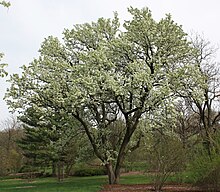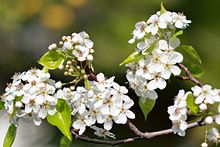| Pyrus calleryana | |
|---|---|

| |

| |
| Scientific classification | |
| Kingdom: | Plantae |
| Clade: | Tracheophytes |
| Clade: | Angiosperms |
| Clade: | Eudicots |
| Clade: | Rosids |
| Order: | Rosales |
| Family: | Rosaceae |
| Genus: | Pyrus |
| Species: | P. calleryana
|
| Binomial name | |
| Pyrus calleryana | |
| Synonyms[1] | |
|
List
| |
Pyrus calleryana, also known as the Callery pear or Bradford pear, is a species of pear tree native to China and Vietnam,[2] in the family Rosaceae. It is most commonly known for its cultivar 'Bradford' and its offensive odor, widely planted throughout the United States and increasingly regarded as an invasive species.[2]
Pyrus calleryana is deciduous, growing to 5 to 8 m (16 to 26 ft) tall,[3] often with a conical to rounded crown. The leaves are oval, 4 to 8 cm (1+1⁄2 to 3 in) long, glossy dark green above and pale beneath. They have long petioles alternately arranged on branches.[4] The white, five-petaled flowers are about 2 to 2.5 cm (3⁄4 to 1 in) in diameter. They are produced abundantly in early spring, before the leaves expand fully.
The fruits (which are often assumed to be inedible due to their abundant, cyanide laced seeds) of the Callery pear are small (less than 1 centimetre (3⁄8 in) in diameter), and hard, almost woody, until softened by frost, after which they are readily taken by birds, which disperse the seeds in their droppings. In summer, the shining foliage is dark green and very smooth, and in autumn the leaves commonly turn brilliant colors, ranging from yellow and orange to more commonly red, pink, purple, and bronze. However, since the color often develops very late in autumn, the leaves may be killed by a hard frost before full color can develop.
Callery pears are remarkably resistant to disease or fireblight. However, some cultivars, such as 'Bradford', are particularly susceptible to storm damage and are regularly disfigured or killed by strong winds, winter weather, or limb loss due to their naturally rapid growth rate and acute vertical branching.
The species is named after the Italian-French missionary Joseph-Marie Callery (1810–1862), a sinologue who sent specimens of the tree to Europe from China.[5][6]
- ^ "Pyrus calleryana Decne". Plants of the World Online. Board of Trustees of the Royal Botanic Gardens, Kew. 2017. Retrieved 22 September 2020.
- ^ a b Swearingen, J.; B. Slattery; K. Reshetiloff & S. Zwicker (2010). Plant Invaders of Mid-Atlantic Natural Areas (4th ed.). Washington, D.C.: National Park Service and U.S. Fish and Wildlife Service. p. 168.
- ^ Gu, Cuizhi; Spongberg, Stephen A. "Pyrus calleryana". Flora of China. Vol. 9 – via eFloras.org, Missouri Botanical Garden, St. Louis, MO & Harvard University Herbaria, Cambridge, MA.
- ^ "Callery pear (Bradford pear), Pyrus calleryana Rosales: Rosaceae". www.invasive.org. Retrieved 2023-10-23.
- ^ Reimer, F.C., "A promising new pear stock," The Monthly Bulletin, California State Commission of Horticulture, 5:5 (May 1916), p. 167.
- ^ Bretschneider, Emil (1898), History of European botanical discoveries in China, vol. 1, Sampson Low, p. 525, ISBN 9783863471651